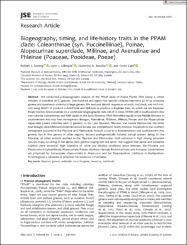| dc.contributor.author | Soreng, Robert John | |
| dc.contributor.author | Gillespie, Lynn Judith | |
| dc.contributor.author | Boudko, Ekaterina A. | |
| dc.contributor.author | Cabi, Evren | |
| dc.date.accessioned | 2022-05-11T14:28:43Z | |
| dc.date.available | 2022-05-11T14:28:43Z | |
| dc.date.issued | 2022 | |
| dc.identifier.issn | 1674-4918 | |
| dc.identifier.issn | 1759-6831 | |
| dc.identifier.uri | https://doi.org/10.1111/jse.12811 | |
| dc.identifier.uri | https://hdl.handle.net/20.500.11776/6919 | |
| dc.description.abstract | We conducted a biogeographic analysis of the PPAM clade of Poeae Plastid DNA Group 2, which includes 12 subtribes of C-3 grasses. One hundred and eighty-four species sampled represent 42 of 43 accepted genera and taxonomic diversity in large genera. We analyzed plastid sequences of matK, trnC-rpoB, and trnT-trnL-trnF using BEAST to produce a dated tree and MrBayes to produce a Bayesian tree, on which we ran Bayesian-Binary-Markov-Chain analyses on a worldwide biogeographic data set of 12 areas. PPAM split in southwestern Asia into subtribe Coleanthinae and PAM clades in the Early Miocene. PAM diversified rapidly in the Middle Miocene in southwestern Asia into four monogeneric lineages, Avenulinae, Phleinae, Miliinae, Poinae, and the Alopecurinae superclade (seven subtribes with 27 genera). In the Late Miocene, Pliocene, and mostly Pleistocene, the latter four lineages diversified and dispersed across Eurasia and established in North America. Dispersals to the southern hemisphere occurred in the Pliocene and Pleistocene. Annuals occur in 15 Mediterranean and southwestern Asia genera, but in few genera in other regions. Beyond phylogenetically isolated annual species dating to the Miocene, all other annuals evolved in the Pliocene and Pleistocene. Cold tolerance is high among perennial species, many occurring in the alpine, nine genera ranging into the Arctic. We suggest that alpine and subalpine habitats were ancestral. High tolerance of saline and alkaline conditions arose between the Pliocene and Pleistocene in Coleanthinae, Alopecurinae, Poinae, Hookerochloinae, Beckmanniinae, and Arctopoa. Combinations are proposed for Cornucopiae alopecuroides in Alopecurus and for Paracolpodium colchicum in Hyalopodium. A nothogenus x Catanellia is proposed for Catabrosa x Puccinellia. | en_US |
| dc.language.iso | eng | en_US |
| dc.publisher | Wiley | en_US |
| dc.identifier.doi | 10.1111/jse.12811 | |
| dc.rights | info:eu-repo/semantics/openAccess | en_US |
| dc.subject | dispersal | en_US |
| dc.subject | grasses | en_US |
| dc.subject | molecular clock | en_US |
| dc.subject | Neogene | en_US |
| dc.subject | taxonomy | en_US |
| dc.subject | worldwide | en_US |
| dc.subject | Bayesian Phylogenetic Inference | en_US |
| dc.subject | Poa Poaceae | en_US |
| dc.subject | Structural Features | en_US |
| dc.subject | Grasses Poaceae | en_US |
| dc.subject | Sequence Data | en_US |
| dc.subject | Tribe Poeae | en_US |
| dc.subject | Evolution | en_US |
| dc.subject | Nuclear | en_US |
| dc.subject | Genus | en_US |
| dc.subject | Classification | en_US |
| dc.title | Biogeography, timing, and life-history traits in the PPAM clade: Coleanthinae (syn. Puccinelliinae), Poinae, Alopecurinae superclade, Miliinae, and Avenulinae and Phleinae (Poaceae, Pooideae, Poeae) | en_US |
| dc.type | article | en_US |
| dc.relation.ispartof | Journal of Systematics and Evolution | en_US |
| dc.department | Fakülteler, Fen Edebiyat Fakültesi, Biyoloji Bölümü | en_US |
| dc.authorid | 0000-0003-3129-434X | |
| dc.institutionauthor | Cabi, Evren | |
| dc.relation.publicationcategory | Makale - Uluslararası Hakemli Dergi - Kurum Öğretim Elemanı | en_US |
| dc.authorscopusid | 6602823444 | |
| dc.authorscopusid | 7006565214 | |
| dc.authorscopusid | 56664471600 | |
| dc.authorscopusid | 33367486100 | |
| dc.identifier.wos | WOS:000742402700001 | en_US |
| dc.identifier.scopus | 2-s2.0-85122744224 | en_US |



















